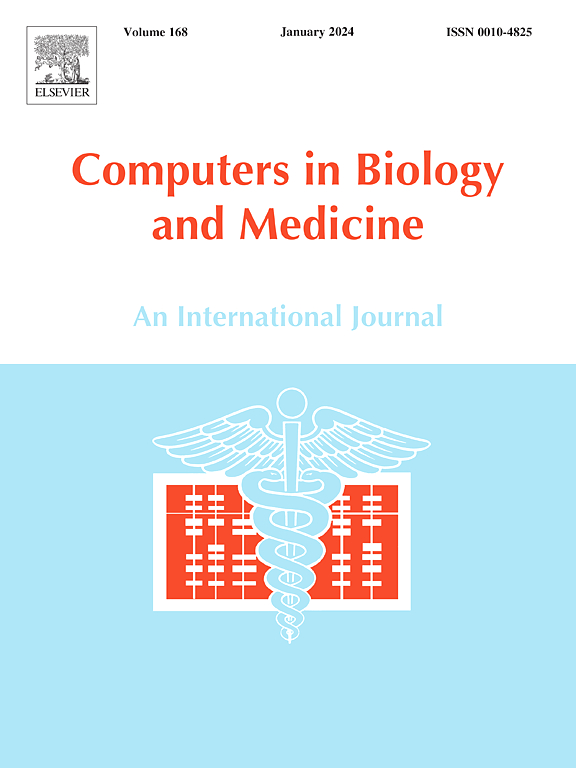DeepPerfusion:一个可理解的双分支深度学习架构,用于基于成像光容积脉搏图的高精度血容量脉搏提取
IF 7
2区 医学
Q1 BIOLOGY
引用次数: 0
摘要
成像光容积脉搏波(iPPG)是一种非接触式提取血容量脉动(BVP)的方法。分析由上层皮肤层光吸收波动引起的小强度变化,可以提取BVP。不均匀的光照或头部运动阻碍了基于ippg的BVP提取。为了减轻这些影响,一个重要的步骤是准确的皮肤分割和加权,这在最先进的(SOTA)深度学习方法中受到的关注不够。因此,我们提出了一种双分支深度学习架构DeepPerfusion,它将精确的皮肤分割和加权以及BVP提取结合到一个模型中。结合我们新开发的基于patch的时间归一化机制和我们创新的训练管道,DeepPerfusion实现了高度精确的BVP提取。我们对来自三个公开数据集的156名受试者进行了全面的性能分析,评估了心率提取的平均绝对误差(MAE)和信噪比(SNR),并将其与经过相同训练和评估流程的9种SOTA方法进行了比较。对于每个数据集的受试者中位数,DeepPerfusion的MAE始终低于每分钟1次,比最佳的SOTA方法高出49%。此外,DeepPerfusion达到至少5.81 dB的高信噪比,比最佳的SOTA方法高出约2至3倍。与SOTA方法相比,DeepPerfusion的表现一致、稳健且高度精确。这证明了DeepPerfusion进行高精度BVP提取的能力。我们期望这将在未来为iPPG开辟新的诊断应用。本文章由计算机程序翻译,如有差异,请以英文原文为准。

DeepPerfusion: A comprehensible two-branched deep learning architecture for high-precision blood volume pulse extraction based on imaging photoplethysmography
Imaging photoplethysmography (iPPG) is a contactless approach for the extraction of the blood volume pulsation (BVP). Analyzing the small intensity changes resulting from fluctuations in light absorption in upper skin layers enables BVP extraction. Inhomogeneous illumination or head movements impede iPPG-based BVP extraction. To mitigate these influences, an important step is the accurate skin segmentation and weighting, which has received insufficient attention in state-of-the-art (SOTA) deep learning-based approaches in particular. Therefore, we propose DeepPerfusion, a two-branched deep learning architecture, that combines precise skin segmentation and weighting as well as BVP extraction into one model. Together with our newly developed patch-based temporal normalization mechanism and our innovative training pipeline, DeepPerfusion achieved highly accurate BVP extraction. We performed a thorough performance analysis and evaluated the mean absolute error (MAE) for heart rate extraction and the signal-to-noise ratio (SNR) on 156 subjects from three publicly available datasets and compared it with nine SOTA approaches that underwent the same training and evaluation pipeline. For the median across subjects of each dataset, DeepPerfusion consistently achieved MAE below 1 beat per minute, outperforming the best SOTA approaches by up to 49 %. Furthermore, DeepPerfusion achieved high SNR with at least 5.81 dB which was about two to three times higher compared to the best SOTA approaches. In contrast to SOTA approaches, DeepPerfusion’s performance was consistent, robust and highly precise. This demonstrates DeepPerfusion’s ability to perform high-precision BVP extraction. We expect this to open up new diagnostic applications for iPPG in the future.
求助全文
通过发布文献求助,成功后即可免费获取论文全文。
去求助
来源期刊

Computers in biology and medicine
工程技术-工程:生物医学
CiteScore
11.70
自引率
10.40%
发文量
1086
审稿时长
74 days
期刊介绍:
Computers in Biology and Medicine is an international forum for sharing groundbreaking advancements in the use of computers in bioscience and medicine. This journal serves as a medium for communicating essential research, instruction, ideas, and information regarding the rapidly evolving field of computer applications in these domains. By encouraging the exchange of knowledge, we aim to facilitate progress and innovation in the utilization of computers in biology and medicine.
 求助内容:
求助内容: 应助结果提醒方式:
应助结果提醒方式:


